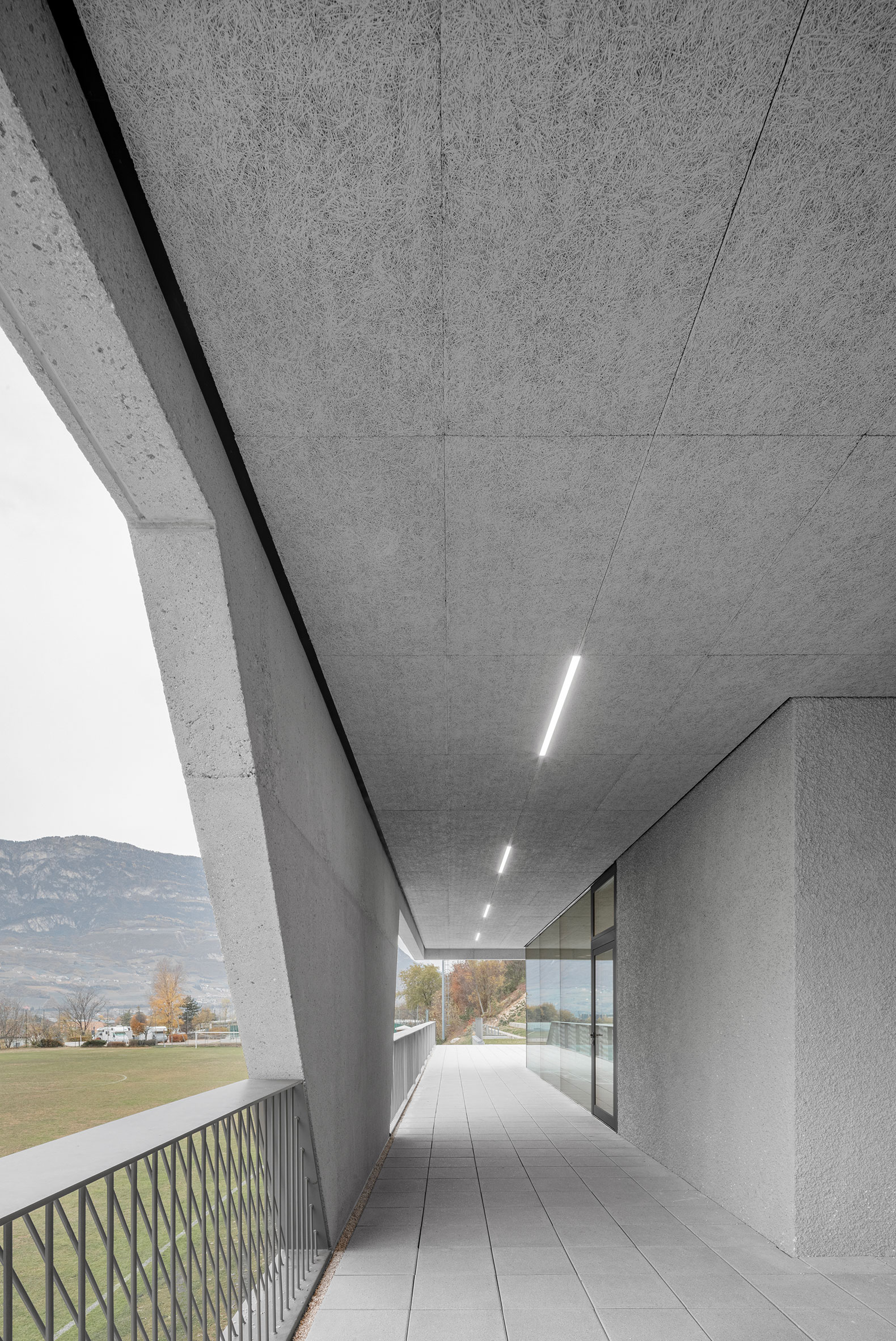On the east side, a light tower that tapers as it grows acts both as a counterweight and as a visual landmark in the landscape. The roof of the building houses the 52 photovoltaic modules that cover 50% of its energy consumption. The two-story structure, one half-buried and the other above ground with a large attached terrace, is made of reinforced concrete exposed in situ. The glazed openings are inspired by the shape of the place, creating a uniform envelope interrupted by trapezoidal pillars at some points.
Fieldhouse's goal is to elevate the functional nature of the sports field and generate an inclusive common space, where sport merges with other activities, so that the whole community can enjoy it.

Fieldhouse by MoDusArchitects. Photograph by Gustav Willeit.

Fieldhouse by MoDusArchitects. Photograph by Gustav Willeit.
Project description by MoDusArchitects
FIELDHOUSE BY MODUSARCHITECTS: Sport architecture goes social, a win-win for the local community
With the Fieldhouse project, architecture office MoDusArchitects www.modusarchitects.com inserts a new material milestone into the South Tyrolean landscape with inclusive spaces dedicated to sports and recreation.
Located in the small town of Laghetti (Egna Municipality, Bolzano) nearby the riverbanks of the Adige river, the building sits at the foothills of Mount Corno whose natural reserve park forms a dramatic backdrop to the sports facility.
Infrastructural in character, Fieldhouse is wedged between a five-a-side football pitch to the north, the existing football field to the west and the steeping terrain to the east. With its low-lying body that transforms as it moves laterally along the site, Fieldhouse mutates from a retaining wall to a long linear roof to then become a raised groundscape that acts not only as a viewing platform for sporting events, but also as an outdoor venue for social occasions.
MoDusArchitects, appointed to demolish the old building that housed the changing rooms and the sports association, proposes a new building with an extension that would improve the building's energy efficiency while reusing the existing photovoltaic system.

Fieldhouse by MoDusArchitects. Photograph by Gustav Willeit.
"Be it football pitch, tennis courts, or baseball diamonds, outdoor recreational fields are precisely constructed landscapes: their shape, size, edges, and orientation on the site are regimented by the rules of the game that they host."
Matteo Scagnol, co-founder of MoDusArchitects.
In many ways, Fieldhouse is a connector piece, part of the larger puzzle of small-town settlements that line the valley basins of South Tyrol: residential neighbourhoods, light-industrial zones and sports infrastructures sit side-by-side in limited swathes of land. Positioned at the point of inflexion between valley and mountain, Fieldhouse is characterized by a regular and elongated plan, while also providing a bold geometrical profile in elevation that measures itself up against the vertical landscape. In section, Fieldhouse mediates the topography with two levels that connect up the various programs and vista points.
Fieldhouse becomes a new community hub dedicated to sports, but also to recreational activities:
"We wanted to give the community a project that was accessible and would grant full visibility to all the activities of the functional programme, especially those aimed at the public and spectators. This sparked the decision to position the volume longitudinally, to accompany visitors in the enjoyment of their leisure time, thereby creating a new social space."
Sandy Attia, co-founder of MoDusArchitects.
The two-storey structure, one partially underground and one above ground with an adjoining large terrace, is made of reinforced - exposed concrete cast in situ. The glazed apertures take cues from the geometries and slopes of the site, forming a uniform envelope punctuated by alternating trapezoidal pillars and sharp cuts at the openings.

Fieldhouse by MoDusArchitects. Photograph by Gustav Willeit.
On the east side, a lighting tower reaching towards the sky, 11 metres high and tapering upwards, acts as a counterweight to the extended body of the Fieldhouse. It incorporates the requisite lighting poles into an architectural element that delineates the outermost corner of the building—a hinge between built volume and the ground—to become a visual marker in the landscape.
The tower is an integral part of the roofscape whose long, flat roof houses the 52 photovoltaic modules. Thanks to a system that covers 50% of its energy consumption with renewable sources, the new building is CasaClima A certified.
From the entrance forecourt, a wide panoramic covered staircase leads to the first floor which hosts the caretaker's apartment, offices, a meeting and teaching room, the cafeteria area and kitchen with indoor and outdoor dining areas, and a large terrace for parties and public meetings.
The ground floor houses the new changing rooms with showers and toilets for 30 players, with a direct connection to both the football pitch and the inside of the building.

Fieldhouse by MoDusArchitects. Photograph by Gustav Willeit.
Here in addition to the storage facilities for the sports equipment is located in the independently operated, local division of the Tiroler Schützen with a small indoor shooting range and dedicated storage area. The association is rooted in the local culture of South Tyrol and once constituted the former voluntary army.
The design of the Fieldhouse by MoDusArchitects reflects on the architecture of local sports facilities and their public character, tracing the outlines of a typology little explored in the Italian scene.
The relevance of the Fieldhouse for the local community elevates the functional nature of the sports field and generates an inclusive space where sports-centred services merge with recreational spaces that the entire local community can enjoy.
















































